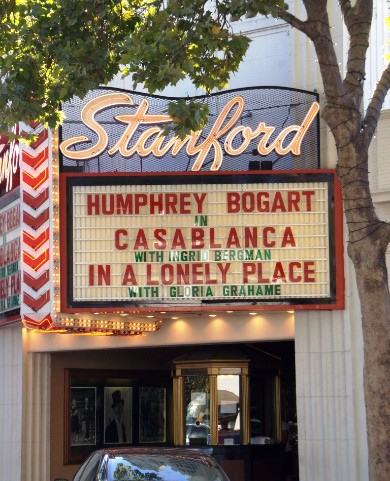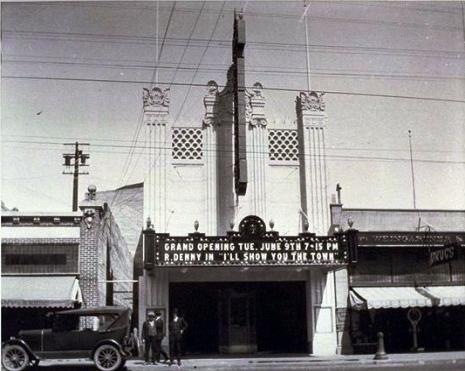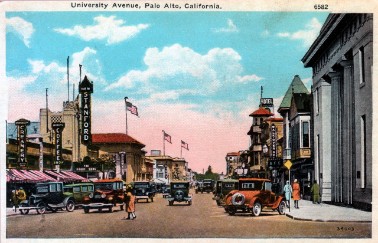The Stanford Theatre: As Time Goes By
For a time in its history it seemed that the Stanford Theatre, Palo Alto’s oldest and grandest movie house, would suffer the unfortunate fate of most single-screen theatres of yesteryear. As cable and color television, VCRs and year-round TV sports lured people to stay home on Friday and Saturday nights --- and big screen
multiplexes opened within a short freeway drive --- the Stanford began to sink ever further down the cinematic food chain, eventually showing second-run Hollywood action flicks while remaining poised on the verge of being eaten up by shops and restaurants.
But thanks to the David and Lucile Packard Foundation and the zeal of the billionaire’s son, movie buff David Woodley Packard, the story of the Stanford has a happy ending after all. It just goes to show what a little vision and $8 million can do.
But no matter how high the price tag for the theatre’s restoration and operation, today the Stanford is one of Palo Alto’s treasures, sending lines of patrons around the block for Casablanca, Citizen Kane and the annual Christmas Eve showing of It’s a Wonderful Life. Indeed, it’s the Stanford that gives Palo Alto the same kind of small-town charm that inspired George Bailey to run down Main Street calling out his hellos to Bedford Falls.
The Stanford --- or New Stanford as it was then known --- was built in 1925 for $300,000, replacing its predecessor as part of the Peninsula Theatre Company chain. It was immediately billed in the local papers as “The pride of the Peninsula…the last word in theatre construction.” As one of the finest movie houses in California in its early years, it featured the most modern amenities of the day. A “mushroom” ventilation system allowed for even temperature control throughout the theatre, a “remote control” switchboard system operated the lights and curtain from the projection booth and the Stanford claimed an enormous seating capacity of 1,443.
And that’s about how many came on the evening of June 9th, 1925, when the Stanford opened with a showing of comedian Reginald Denny’s I’ll Show You the Town, highlighted by an appearance by the star himself and an address by the mayor. The Stanford also hosted “high-class vaudeville” acts in its early days, giving Palo Alto a venue for popular culture during the Depression. For the next four decades, the Stanford would be the place to see local premieres of such classics as The Philadelphia Story, Gone with the Wind and Rear Window --- along with the requisite Fox Movietone News and Talkartoons.
But by the late 1960s, the Stanford was no longer drawing the big crowds. For a time, it became a performing arts theatre, hosting off-off Broadway shows as well as classic musicals like Oklahoma! and South Pacific as well as fading pop acts like Tower of Power. Such experiments soon led to financial disaster and it all ended up with a “For Sale” sign up on the marquee.
By the early 1980s, the Stanford was playing movies again, but of a second-run variety. You could see Hollywood blockbusters months after their release. And if you were willing to put up with the Stanford’s peeling paint and rusted seats, you could get in for 50 cents --- a dime less than the price of a film when the theatre first opened nearly six decades earlier.
But just as it looked as if the Stanford’s days were numbered, a white knight came forth in the person of David Woodley Packard. Although the onetime classics professor had not been interested in film until the age of 35 when a friend took him to see the Wizard of Oz, Packard had since developed a nearly fanatical passion for the fate of old movies. In 1987, he rented out the Stanford for a week to serenade friends with a fortnight of Fred Astaire pictures. The results were phenomenal. More than a 1,000 people lined up each night to see Fred and Ginger dance cheek to cheek. Packard began to flirt with the idea of buying the Stanford and when his old man came by and saw the crowds, the elder
Packard gave his assent to the plan.
David threw himself into the restoration project. Using old photographs and company file notes, he and his crew were able to reconstruct the Stanford’s glory days. Back were the original Greek-Assyrian paintings on the theatre’s 50 foot-high ceiling. Also restored were the handmade stair tiles, seven chandeliers, stage pillars, urns and the theatre’s piece de resistance --- the Mighty Wurlitzer organ that ascends and descends into the orchestra pit. Even the theatre’s original snack bar and ticket booth were replicated with complete accuracy. In the end, it took less time (and a lot less money) to build the theatre in the first place than to do the painstaking restoration.
In the years since, the Stanford has become a place where classics are both shown and saved. Packard has close ties to the UCLA film archive, maintaining his own preservation lab on the UCLA grounds. There he has helped convert --- at $10,000 apiece --- many films whose only prints were previously at risk on unstable and highly flammable nitrate stock. Such new prints have often premiered at the Stanford. Still, sometimes Packard’s love for the old cinema can impair his sense of what will turn a profit. After all, it’s probably only the die-hard classics fans who are lining up to for tickets to Harold Lloyd film festivals.
But Packard was correct in predicting that there was a stable audience in town for Hollywood’s Golden Age --- and not just among blue-haired set. More people saw the 50th anniversary re-release of Casablanca at the Stanford than anywhere else in the country and over the last decade the theatre has accounted for a remarkable 25 percent of the nationwide attendance of classic films. And for the local movie aficionado, it is a distinct pleasure to have a place in town where you can rock back in a red wool mohair seat, dig into a box of popcorn and follow the Yellow Brick Road. []
Our Reader's Memories:
"When I was in high school and one night a year the fraternity boys would walk down University wearing their pajamas to the movie theatre. And they would just show up there and watch the movie wearing their pajamas. People thought that was very funny!"
-Kim
"When I was a kid in the late 60's we used to go to the Stanford every weekend on Saturday morning. They showed about 3 hours of cartoons and then some goofy western like the Lone Ranger or Zorro. At some point someone threw an apple at the screen and it made a big noticeable hole in the screen. They tried to patch it up but the dent was there for years after."
-Kevin
"I don't remember the movies I saw there back in '74 or '75, but I remember it was the only place that served espresso and I thought that was so cool, so artsy. so sophisticated. That impressed me more than the movies! I still love espressos - thank god we have coffee bars now. I wish we still had more small movie theaters like this or the one on Hamilton where you could sit on the floor."
-Ann
"I went to the summer Tuesday fifty cent program every summer in the late 1950's. It was crowded with kids and great fun. When I was older (grown up at 11) my older brother Doug was the projectionist so I got to see movies for free! I will always remember the fun and the magic of the Stanford Theatre. "
-Robert
Send Us Your Memory!


The Stanford Theatre on its opening day in 1925. (PAHA)

David Woodley Packard, The Stanford's savior. (PAHA)

The Stanford appears at left in this colorful Palo Alto postcard. (PAHA)

Inside the grand theatre.